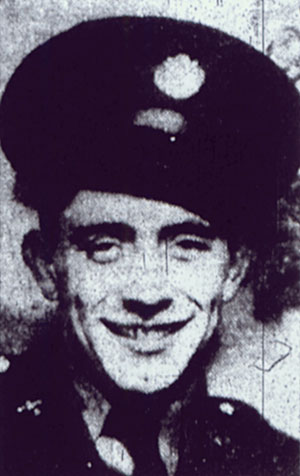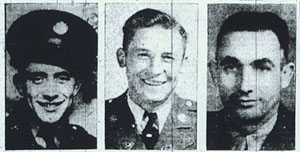

Remember...
Amon Adkins
1921-1944
"How often we fail to realize our good fortune in living in a country where happiness is more than a lack of tragedy."
 |
Remember...Amon Adkins
|
Technician Corporal Amon Adkins was born at McComas, Cabell County, West Virginia, on March 17, 1921. The son of Millard Fillmore (born c. 1885) and Vera McComas (born c. 1889) Adkins, he was the eighth child in a family of at least nine siblings. According to the1920 and 1930 Federal Census, M. F. and Vera's large brood consisted of brothers Ivel, Olin [Olan], Ovel [Oval], Warren, Amon, and Allis and sisters Erma [Irma], Rena, and Vita.
Although little is known of the early life of Amon, he enlisted in the Army on July 29, 1942, at Huntington, West Virginia. At that time, he stated that he had a grammar school education, was employed among "semiskilled chauffeurs and drivers, [i.e.] bus, taxi, truck, and tractor [drivers], and was "single, without dependents." A feature in the Huntington Herald-Advertiser of October 10, 1943, pictures Technician Corporal Amon along with brothers Private First Class Warren H. and Private Olan. Brief notations with the pictures indicate that Warren was serving with the U.S. Infantry on an island in the South Pacific, while Olan was recently sent overseas with the U.S. Cavalry and was serving in India.

Sadly, the marriage was to be short lived. T/Cpl. Adkins was killed on Christmas Eve 1944, when the SS Leopoldville was sunk off the coast of France by a German U-boat (U-486).
A detailed account of the sinking of the troop transport Leopoldville is told in Part 9 of The Sea Hunters: True Adventures with Famous Shipwrecks (New York: Simon & Schuster, 2003, 2nd ed., pp. 305-325). Adventure novelist Clive Cussler and his co-author Craig Dirgo write compellingly about the tragedy as they weave a tale of fact and supposition about the events that led to the loss of the ship. It is a story of an operation gone wrong, fraught with disorganization, miscommunication, confusion, and chaos. Intended to reinforce troops exhausted by and decimated in the Battle of the Bulge, the 262nd and 264th Regiments of the U.S. Infantry finally received orders on December 23 to move out from Southampton, England, to Cherbourg, France. The L opoldville and another troop transport, SS Cheshire, began boarding at 0200 hours on the 24th.
Originally a Belgian passenger liner, the Leopoldville had been under charter to the British Admiralty since the beginning of the war. Though the L opoldville had been retrofitted to be a troop ship, it had a tired and worn appearance to the troops. The ship was under the command of Flemish Captain Charles Limbor, who had spent a quarter century with the Belgian Lines and was considered a quiet, but competent, seaman. The Leopoldville had crossed the Channel many times and transported many troops without incident. But this crossing would be different. There was no great enthusiasm among the men for moving into the European theater; after all, it had been more than six months since D-Day, and many assumed that the action was winding down. Skipping a partially prepared Christmas dinner, they were rushed onto the boats and then had a lengthy wait before setting sail. Boarding was particularly chaotic; first, a company of paratroopers had been boarded and then taken off. Cussler calls the boarding "a further omen of the tragedy to come" (p. 307). The two regiments were mixed together, and instead of boarding by platoon, the men simply boarded in the order in which they appeared. There was no plan for providing sleeping space for the troops, despite the fact that they would be on ship for eighteen hours before disembarking. In addition, they had not been trained in how to launch the ship's lifeboats or how to wear lifejackets.
The Leopoldville had never before crossed in a zigzag fashion, but was ordered to do so this time because of known submarine activity. At about 1754 hours, the ship suffered a torpedo strike. Most of the men in the lower compartments were lost at this time, but a few escaped and made it to the upper deck. Among the survivors of the initial strike, there seemed to be little panic. But then a series of miscommunications began. Captain Limbor made the assumption they were sinking swiftly and ordered all but essential crew to abandon ship. Abandon ship they did:the American troops watched in shock as the Belgian and Congolese crew left ahead of them on the lifeboats. Cussler calls the behavior of the troops waiting on deck for rescue "one of the finest examples of discipline ever observed." He adds: "All stood in blind obedience awaiting orders that never came" (p. 322). Though rescue ships would eventually come from Cherbourg, they were in no hurry to get to the ship due to the delay in communications. And because of Christmas celebrations, the rescue ships were lightly manned. The loudspeaker was no longer working, so Captain Limbor walked around the ship giving orders to the remaining men:in French or Flemish:which added to the confusion about launching lifeboats.
Men began jumping into the icy water of the Channel in full gear; they did not know to divest themselves of their heavy clothing and gear and did not know how to activate their life jackets. Of those who did not die of hypothermia in the water, some died ashore at Cherbourg because medics overlooked signs of life. While 1,400 infantrymen had survived, nearly 800 U.S. infantry were dead.
Although the German media broadcast details of the sinking as early as January 7, 1945, a month passed before it was acknowledged in U.S. newspapers, and even then it appears that the account was deliberately inaccurate. On January 25, the Philadelphia Inquirer Washington bureau quoted Secretary of War Henry Stimson as saying "the ship sank swiftly . . . and 248 men were killed and 517 are missing. The rest, over 1400, were saved."
We now know, of course, that the ship did not sink swiftly, and the missing men were, in fact, dead. Subsequent investigations criticized Commander John Pringle, Commander of the Brilliant, lead ship of the convoy. Pringle received an official reprimand, but was allowed to continue his naval career. Captain Limbor, the only officer not to survive the sinking, went down with the Leopoldville. Investigations also faulted him and his crew: He failed to accurately asses the damage to the ship; had he done so, he would have known they were sinking slowly, not rapidly. The ship could have been towed. He could have facilitated better communication with the troops and given better instructions for using lifeboats and other equipment.
There were a number of reasons for the cover-up of the actual details of the sinking, one having to do with maintaining the morale of the troops. The silence was comparable to that which withheld details concerning the losses during the Battle of the Bulge, potentially demoralizing and embarrassing the Allied forces at the time.
Of the nearly 800 U.S. troops who perished on the Leopoldville, 493 were never recovered. Of those who were recovered, many are still interred in St. M re Eglise or Normandy American Cemetery, even though in 1947 the United States allowed their families to bring them to the states for burial. (Summary based on Part 9 of the Cussler/Dirgo book and Tonya Allen's article "The Sinking of the SS Leopoldville," http://uboat.net/history/leopoldville.htm [accessed Nov. 11, 2011].)
Cabell County death records list Amon Adkins on the 1948 register but do not provide an actual date of death, indicating he was most likely brought home for burial at that time.
Article by Patricia Richards McClure.

West Virginia Archives and History welcomes any additional information that can be provided about these veterans, including photographs, family names, letters and other relevant personal history.